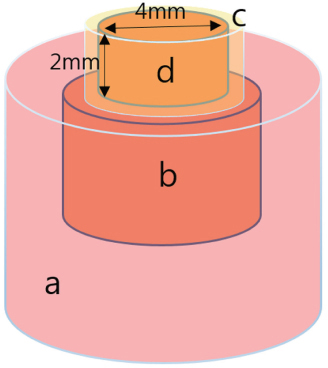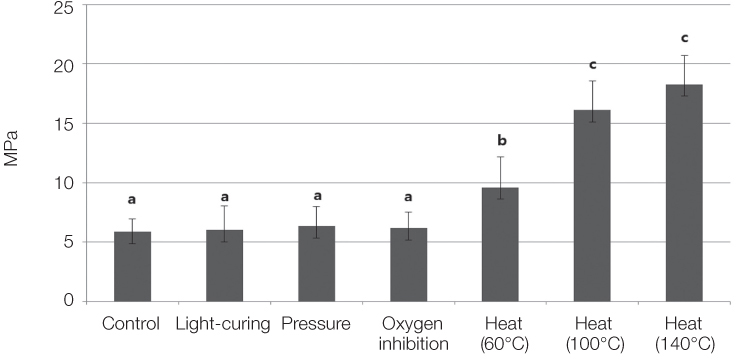J Adv Prosthodont.
2015 Feb;7(1):47-50. 10.4047/jap.2015.7.1.47.
Effect of light-curing, pressure, oxygen inhibition, and heat on shear bond strength between bis-acryl provisional restoration and bis-acryl repair materials
- Affiliations
-
- 1Korea University Ansan Hospital, Prosthodontics, Ansan, Republic of Korea.
- 2Korea University Guro Hospital, Prosthodontics, Seoul, Republic of Korea.
- 3Korea University Anam Hospital, Prosthodontics, Seoul, Republic of Korea. koproth@unitel.co.kr
- KMID: 1974890
- DOI: http://doi.org/10.4047/jap.2015.7.1.47
Abstract
- PURPOSE
This study aimed to discover a way to increase the bond strength between bis-acryl resins, using a comparison of the shear bond strengths attained from bis-acryl resins treated with light curing, pressure, oxygen inhibition, and heat.
MATERIALS AND METHODS
Self-cured bis-acryl resin was used as both a base material and as a repair material. Seventy specimens were distributed into seven groups according to treatment methods: pressure - stored in a pressure cooker at 0.2 Mpa; oxygen inhibition- applied an oxygen inhibitor around the repaired material,; heat treatment - performed heat treatment in a dry oven at 60degrees C, 100degrees C, or 140degrees C. The shear bond strength was measured with a universal testing machine, and the shear bond strength (MPa) was calculated from the peak load of failure. A comparison of the bond strength between the repaired specimens was conducted using one-way ANOVA and Tukey multiple comparison tests (alpha=.05).
RESULTS
There were no statistically significant differences in the shear bond strength between the control group and the light curing, pressure, and oxygen inhibition groups. However, the heat treatment groups showed statistically higher bond strengths than the groups treated without heat, and the groups treated at a higher temperature resulted in higher bond strengths. Statistically significant differences were seen between groups after different degrees of heat treatment, except in groups heated at 100degrees C and 140degrees C.
CONCLUSION
Strong bonding can be achieved between a bis-acryl base and bis-acryl repair material after heat treatment.
Keyword
MeSH Terms
Figure
Reference
-
1. Young HM, Smith CT, Morton D. Comparative in vitro evaluation of two provisional restorative materials. J Prosthet Dent. 2001; 85:129–132.2. Tjan AH, Castelnuovo J, Shiotsu G. Marginal fidelity of crowns fabricated from six proprietary provisional materials. J Prosthet Dent. 1997; 77:482–485.3. Chen HL, Lai YL, Chou IC, Hu CJ, Lee SY. Shear bond strength of provisional restoration materials repaired with light-cured resins. Oper Dent. 2008; 33:508–515.4. Hagge MS, Lindemuth JS, Jones AG. Shear bond strength of bis-acryl composite provisional material repaired with flowable composite. J Esthet Restor Dent. 2002; 14:47–52.5. Bohnenkamp DM, Garcia LT. Repair of bis-acryl provisional restorations using flowable composite resin. J Prosthet Dent. 2004; 92:500–502.6. Hammond BD, Cooper JR 3rd, Lazarchik DA. Predictable repair of provisional restorations. J Esthet Restor Dent. 2009; 21:19–24.7. Tanoue N, Matsumura H, Atsuta M. Comparative evaluation of secondary heat treatment and a high intensity light source for the improvement of properties of prosthetic composites. J Oral Rehabil. 2000; 27:288–293.8. Murakami N, Wakabayashi N, Matsushima R, Kishida A, Igarashi Y. Effect of high-pressure polymerization on mechanical properties of PMMA denture base resin. J Mech Behav Biomed Mater. 2013; 20:98–104.9. Velazquez E, Vaidyanathan J, Vaidyanathan TK, Houpt M, Shey Z, Von Hagen S. Effect of primer solvent and curing mode on dentin shear bond strength and interface morphology. Quintessence Int. 2003; 34:548–555.10. Bausch JR, de Lange C, Davidson CL. The influence of temperature on some physical properties of dental composites. J Oral Rehabil. 1981; 8:309–317.11. Lutz F, Phillips RW, Roulet JF, Setcos JC. In vivo and in vitro wear of potential posterior composites. J Dent Res. 1984; 63:914–920.12. Wendt SL Jr. The effect of heat used as secondary cure upon the physical properties of three composite resins. II. Wear, hardness, and color stability. Quintessence Int. 1987; 18:351–356.13. Covey DA, Tahaney SR, Davenport JM. Mechanical properties of heat-treated composite resin restorative materials. J Prosthet Dent. 1992; 68:458–461.14. Cook WD, Johannson M. The influence of postcuring on the fracture properties of photo-cured dimethacrylate based dental composite resin. J Biomed Mater Res. 1987; 21:979–989.15. Wendt SL Jr. The effect of heat used as a secondary cure upon the physical properties of three composite resins. I. Diametral tensile strength, compressive strength, and marginal dimensional stability. Quintessence Int. 1987; 18:265–271.16. Ha JY, Kim SH, Kim KH, Kwon TY. Influence of the volumes of bis-acryl and poly(methyl methacrylate) resins on their exothermic behavior during polymerization. Dent Mater J. 2011; 30:336–342.17. Wendt SL Jr. Time as a factor in the heat curing of composite resins. Quintessence Int. 1989; 20:259–263.18. Ferracane JL, Condon JR. Post-cure heat treatments for composites: properties and fractography. Dent Mater. 1992; 8:290–295.
- Full Text Links
- Actions
-
Cited
- CITED
-
- Close
- Share
- Similar articles
-
- Effect of delayed time, surface treatment, and repair material on shear bond strength of repaired bis-acryl composite resin
- Chemical compatibility of interim material and bonding agent on shear bond strength
- A study on the shear bond strength between 3D printed resin and provisional resin after thermal cycling
- Bonding of conventional provisional resin to 3D printed resin: the role of surface treatments and type of repair resins
- The effect of different fiber reinforcements on flexural strength of provisional restorative resins: an in-vitro study



